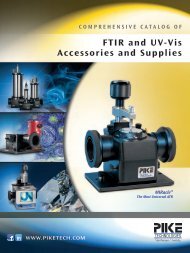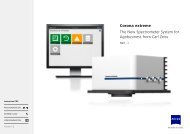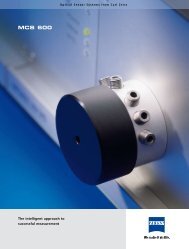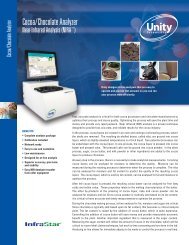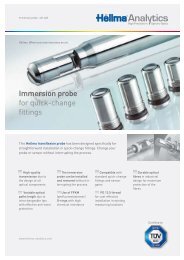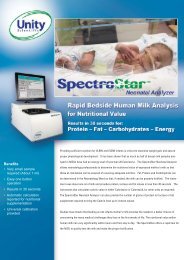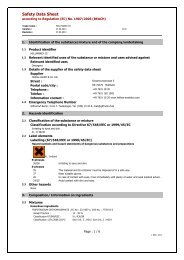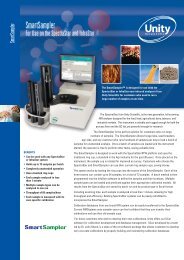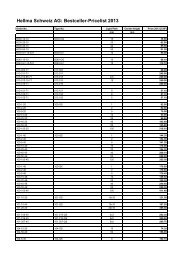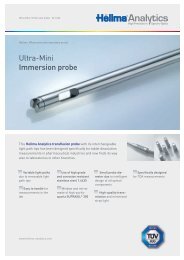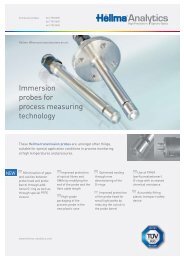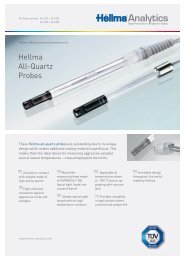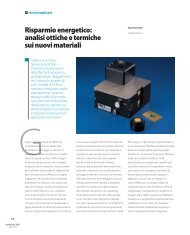Chemometric Database Management Software - Hellma Analytics
Chemometric Database Management Software - Hellma Analytics
Chemometric Database Management Software - Hellma Analytics
You also want an ePaper? Increase the reach of your titles
YUMPU automatically turns print PDFs into web optimized ePapers that Google loves.
UCal<br />
UCal<br />
<strong>Chemometric</strong> <strong>Database</strong> <strong>Management</strong> <strong>Software</strong><br />
Unity<br />
Scientif ic<br />
The UCal software is a powerful software tool for managing<br />
databases and developing calibrations. UCal is designed to<br />
ensure that calibrations are accurate by using databases<br />
that have been properly optimized to contain the correct<br />
samples. This intuitive, state of the art software is simple to<br />
use, yet powerful enough for even the most advanced user.<br />
Easy File <strong>Management</strong><br />
The UCal software is an intuitive Windows based program. Its logical data file<br />
structure allows for sets of data to be reviewed and combined with ease. Spectra files can<br />
easily be imported and exported along with constituent information to simplify the file<br />
management process. A graphical interface allows for quick and easy viewing of spectral<br />
data. Spectral graphs, calibration graphs, and text data can all be exported to other<br />
Windows programs for use in building reports and presentations.<br />
UCal - Structure <strong>Database</strong>s &<br />
Calibrate<br />
<strong>Database</strong> Building and<br />
Condensing with ND<br />
The UCal software contains a powerful file conversion section that converts spectral data<br />
from multiple vendor instruments into the UCal format. This means that UCal can be used<br />
on multiple vendor platforms. Data can be imported to and exported from UCal using<br />
Unity .svf format, j-camp (.dx, .jdx), Grams (.spc), NIRSystems (.nir and .cal), and other<br />
formats. Spectral data can be truncated and interpolated to match wavelength ranges<br />
when transferring a database.<br />
UCal provides standardization to match a network of instruments to a “Master” instrument.<br />
This standardization feature can even accommodate instruments from different vendors.<br />
UCal also provides features to transfer an existing calibration database to the SpectraStar,<br />
while then be able to add new samples to the transferred database.<br />
Easy Calibration Development<br />
UCal provides a powerful, yet easy calibration development process for building the most<br />
accurate calibrations. With a single screen calibration interface, a compact file structure<br />
where a single calibration equation file is used for all constituents, and single push button<br />
operation, UCal makes creating calibrations easy.
UCal<br />
UCal<br />
Benefits/Features<br />
• Easy to use<br />
• Single screen calibration interface<br />
• Compact file structure - single<br />
calibration equation file for all<br />
constituents<br />
• Powerful calibration tools<br />
- PLS algorithm using<br />
neighborhood distance principle<br />
- Condense Algorithm for<br />
database optimization<br />
- Minimization (MIN) file to<br />
remove unwanted variation<br />
from the spectra<br />
• Neighborhood distances use PLS<br />
(partial least squares) instead of<br />
PCA (principle component<br />
analysis) for database structuring<br />
- Each constituent has its own<br />
distribution<br />
- Best possible mathematical<br />
model to enhance the accuracy<br />
of the product database<br />
- Provides confidence that the<br />
predicted values are accurate<br />
- Provides the best tool to identify<br />
new samples for a database –<br />
chemistry can be run for<br />
specific constituents as<br />
opposed to running all<br />
constituents in a PCA structure.<br />
- Save thousands of dollars in<br />
maintaining and adding to a<br />
database over time.<br />
• Can be used on multiple vendor<br />
platforms<br />
For quantitative calibrations, UCal supports optimized PLS (Partial Least Squares)<br />
chemometric models. Optimized PLS uses the Neighborhood Distance (ND) Principle to<br />
optimize and build databases using PLS instead of PCA (Principle Component Analysis) to<br />
organize and structure the database. With this principle, UCal includes a patented<br />
Condensing algorithm to remove unwanted redundancy from large databases. Properly<br />
structuring a database in this way will greatly improve the calibration’s accuracy.<br />
Because the Neighborhood Distance Principle relies on PLS mathematics, databases are<br />
optimized per constituent as opposed to other software packages that only focus on PCA,<br />
which doesn’t factor in constituent variation. This means that with UCal, each constituent<br />
will have its own sample distribution, leading to the best possible accuracy.<br />
Using the ND Principle, UCal provides the best tool to identify new samples for a<br />
calibration database. Because the software is focusing on individual constituents, wet<br />
chemistry is only necessary for specific constituents as opposed to analyzing for all<br />
constituents in a PCA structure. This saves thousands of dollars in wet chemistry costs for<br />
building and maintaining calibrations and databases.<br />
UCal includes standard math treatments such as absorbance, 1st through 4th derivatives<br />
with configurable gap and smoothing segments, SNV, Detrend, and more for developing<br />
accurate, stable calibrations. Math treatments can be customized for even greater<br />
flexibility. The Minimization (MIN) File helps to minimize unwanted variation in the data<br />
due to sampling effects or instrument differences. UCal provides automatic outlier<br />
diagnostics with various selection criteria on T and GH statistics to eliminate bad samples<br />
and simplify the calibration process. UCal also provides an off-line prediction tool for<br />
predicting spectra against multiple calibrations.<br />
Unity boasts some of the finest technical specialists in the world. Our employees have an<br />
average of 19 years of experience implementing NIR technology on most NIR brand<br />
models. Our experienced staff can provide the training necessary for quick and easy<br />
implementation of UCal for calibration development and database management.<br />
Unity<br />
Scientific<br />
Unity Scientific, LLC<br />
117 Old State Road<br />
Brookfield, CT 06804<br />
USA<br />
Phone: 540-338-8991<br />
Fax: 540-338-8992<br />
www.unityscientific.com<br />
Email: info@unityscientific.com<br />
Unity Scientific, SpectraStar, CalStar, UniStar,<br />
UCal, UScan, TransStar, QStar, InfraStar and<br />
UltraStar are trademarks of Unity Scientific, LLC.<br />
All other trademarks are the property of their<br />
respective companies.<br />
©Copyright 2010 All rights reserved<br />
UScan<br />
UScan allows calibration equations that were<br />
developed using the UCal software to be used<br />
on multiple vendor platforms. UScan runs over<br />
the top of the routine operation software and<br />
provides predicted results from calibrations<br />
developed in UCal. All results are stored with<br />
date and time stamps. All spectra are stored in<br />
Unity format .svf files for use with the UCal software. Samples flagged in UScan as<br />
ND outliers are stored separately so that they can easily be added to the calibration<br />
database. The UScan software brings the power of the UCal software to other<br />
vendor NIR instrumentation.



